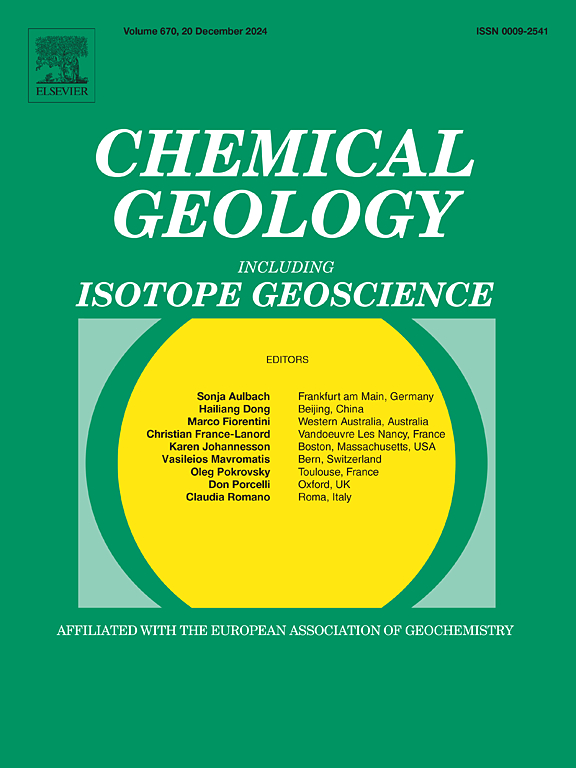Changes in the global P cycle in the Neoproterozoic recorded by the compositions of arc lavas
IF 3.6
2区 地球科学
Q1 GEOCHEMISTRY & GEOPHYSICS
引用次数: 0
Abstract
The mafic lavas erupted at active subduction zones have higher P/Nd ratios than the bulk continental crust. This difference has been explained by the delamination of apatite-rich lower crust, transferring P from the crust to the mantle at subduction zones. Here we compile geochemical data from arc basalts (5.5–6.5 wt% MgO) that have formed in the last 2 Ga and show that Proterozoic arcs erupted basalts with lower average P6/Nd6 ratios than those of Phanerozoic fossil and active arcs. The P6/Nd6 ratios of active arc basalts are negatively correlated with Th6/La6 and positively correlated with Sr6/Th6, Ba6/Th6 and 143Nd/144Nd, indicating that high P6/Nd6 ratios in arc lavas are not inherited from subducted sediments, which generally have low P/Nd ratios. Phosphatised basaltic oceanic crust has high P contents and P/Nd ratios due to interaction with seawater, and metalliferous sediments deposited at active spreading ridges have very high P contents (2000–16,000 ppm) and P/Nd ratios (100–1456) due to coprecipitation of P with Fe-oxyhydroxides formed when reducing hydrothermal vent fluids mix with oxygenated deep ocean water. We propose that the lower P/Nd ratios of Proterozoic mafic arc lavas are the result of lower concentrations of P in seawater at that time. An increase in the P content of seawater at the end of the Proterozoic, coincident with the Neoproterozoic Oxygenation Event, is reflected in lower concentrations of P in marine sediments before 800 Ma, and in 1.3 Ga metalliferous sediments. The high P/Nd ratios of many young arc lavas are therefore not representative of those formed during most of Earth's history. Since most of the continental crust was formed before the end of the Proterozoic, less delamination of apatite-bearing lower crust may be needed to the explain the low P/Nd ratio of the bulk continental crust.
由弧熔岩组成记录的新元古代全球磷旋回变化
在活动俯冲带喷发的基性熔岩比大块大陆地壳具有更高的P/Nd比值。这种差异可以解释为富含磷灰石的下地壳的分层作用,在俯冲带将P从地壳转移到地幔。本文收集了近2 Ga形成的弧玄武岩(5.5 ~ 6.5 wt% MgO)的地球化学资料,发现元古代弧喷发玄武岩的平均P6/Nd6比值低于显生宙化石和活动弧。活动弧玄武岩的P6/Nd6比值与Th6/La6呈负相关,与Sr6/Th6、Ba6/Th6、143Nd/144Nd呈正相关,表明弧玄武岩的高P6/Nd6比值并非继承自俯冲沉积,而俯冲沉积通常具有较低的P/Nd比值。磷化玄武质海洋地壳由于与海水的相互作用而具有较高的P含量和P/Nd比值,而沉积在活动伸展脊的含金属沉积物由于与深海含氧水的还原性热液混合形成的铁氧化物共沉淀而具有很高的P含量(2000 - 16000 ppm)和P/Nd比值(100-1456)。我们认为元古代基性弧熔岩较低的P/Nd比值是当时海水中P浓度较低的结果。元古代末期海水P含量的增加与新元古代氧合事件一致,反映在800 Ma之前的海洋沉积物中P含量较低,1.3 Ga含金属沉积物中P含量较低。因此,许多年轻的弧熔岩的高P/Nd比率不能代表地球历史上大部分时期形成的熔岩。由于大陆地壳大部分形成于元古代末期之前,因此较少的含磷灰石下地壳拆沉可以解释大块大陆地壳的低P/Nd比。
本文章由计算机程序翻译,如有差异,请以英文原文为准。
求助全文
约1分钟内获得全文
求助全文
来源期刊

Chemical Geology
地学-地球化学与地球物理
CiteScore
7.20
自引率
10.30%
发文量
374
审稿时长
3.6 months
期刊介绍:
Chemical Geology is an international journal that publishes original research papers on isotopic and elemental geochemistry, geochronology and cosmochemistry.
The Journal focuses on chemical processes in igneous, metamorphic, and sedimentary petrology, low- and high-temperature aqueous solutions, biogeochemistry, the environment and cosmochemistry.
Papers that are field, experimentally, or computationally based are appropriate if they are of broad international interest. The Journal generally does not publish papers that are primarily of regional or local interest, or which are primarily focused on remediation and applied geochemistry.
The Journal also welcomes innovative papers dealing with significant analytical advances that are of wide interest in the community and extend significantly beyond the scope of what would be included in the methods section of a standard research paper.
 求助内容:
求助内容: 应助结果提醒方式:
应助结果提醒方式:


